中国全要素生产率估算与分析
- 格式:ppt
- 大小:2.32 MB
- 文档页数:85
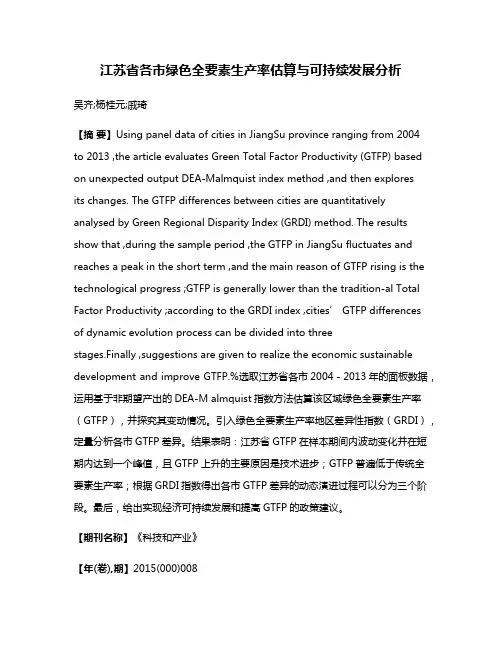
江苏省各市绿色全要素生产率估算与可持续发展分析吴齐;杨桂元;戚琦【摘要】Using panel data of cities in JiangSu province ranging from 2004to 2013 ,the article evaluates Green Total Factor Productivity (GTFP) based on unexpected output DEA‐Malmquist index method ,and then exploresits changes. The GTFP differences between cities are quantitatively analysed by Green Regional Disparity Index (GRDI) method. The results show that ,during the sample period ,the GTFP in JiangSu fluctuates and reaches a peak in the short term ,and the main reason of GTFP rising is the technological progress ;GTFP is generally lower than the tradition‐al Total Factor Productivity ;according to the GRDI index ,cities’ GTFP differencesof dynamic evolution process can be divided into threestages.Finally ,suggestions are given to realize the economic sustainable development and improve GTFP.%选取江苏省各市2004-2013年的面板数据,运用基于非期望产出的DEA‐M almquist指数方法估算该区域绿色全要素生产率(GTFP),并探究其变动情况。
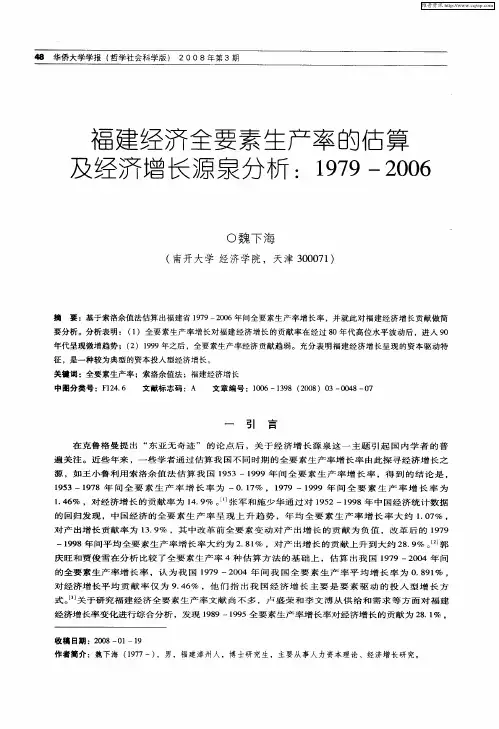
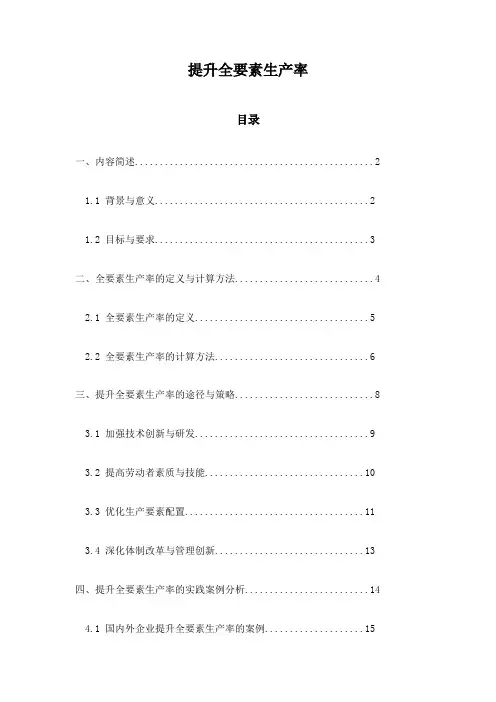
提升全要素生产率目录一、内容简述 (2)1.1 背景与意义 (2)1.2 目标与要求 (3)二、全要素生产率的定义与计算方法 (4)2.1 全要素生产率的定义 (5)2.2 全要素生产率的计算方法 (6)三、提升全要素生产率的途径与策略 (8)3.1 加强技术创新与研发 (9)3.2 提高劳动者素质与技能 (10)3.3 优化生产要素配置 (11)3.4 深化体制改革与管理创新 (13)四、提升全要素生产率的实践案例分析 (14)4.1 国内外企业提升全要素生产率的案例 (15)4.2 政府政策对提升全要素生产率的影响 (17)五、提升全要素生产率的政策建议与保障措施 (18)5.1 完善法律法规与政策体系 (19)5.2 加大投入力度与优化资金配置 (20)5.3 建立健全激励机制与创新文化 (21)六、结论与展望 (22)6.1 结论总结 (24)6.2 展望未来发展趋势与挑战 (25)一、内容简述本文旨在探讨如何通过提升全要素生产率来推动经济发展和社会进步。
全要素生产率是指在数量一定的情况下,生产效率的提升程度,它反映了技术进步、知识积累、制度创新等因素对经济增长的贡献。
文章首先分析了全要素生产率的定义和重要性,然后从理论上阐述了影响全要素生产率的因素,包括技术创新、人力资本、制度环境等。
文章通过实证分析,以中国为例,探讨了全要素生产率的现状及其与经济增长之间的关系。
提出了提升全要素生产率的策略和建议,包括加强科技创新、优化人力资本配置、改善制度环境等,以期为我国经济持续健康发展提供有力支持。
1.1 背景与意义随着全球化进程的加速和科技的日新月异,企业面临着日益激烈的市场竞争。
在这种环境下,提升全要素生产率(Total Factor Productivity, TFP)已成为企业追求持续增长和竞争优势的关键。
全要素生产率是指在数量一定的情况下,生产效率的提升程度,它反映了技术、知识、管理等多种因素的综合影响。
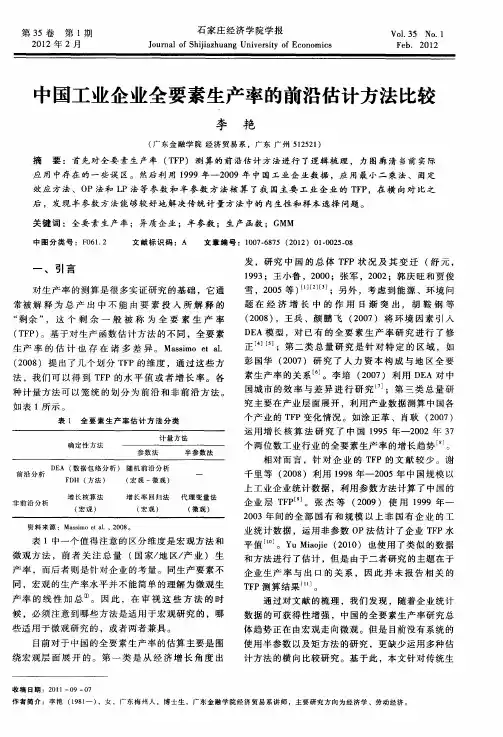
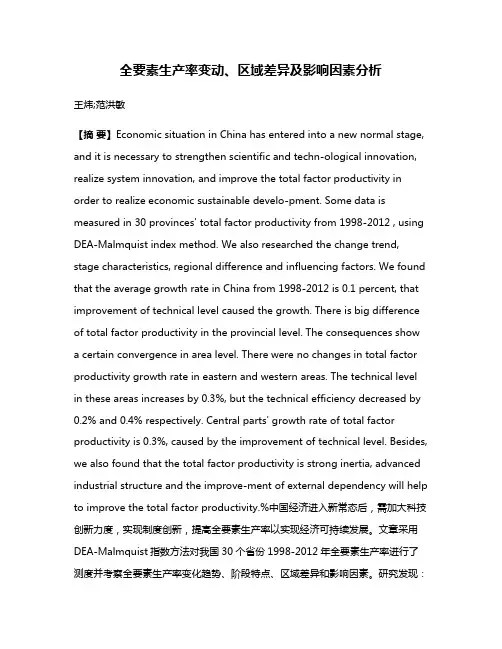
全要素生产率变动、区域差异及影响因素分析王炜;范洪敏【摘要】Economic situation in China has entered into a new normal stage, and it is necessary to strengthen scientific and techn-ological innovation, realize system innovation, and improve the total factor productivity in order to realize economic sustainable develo-pment. Some data is measured in 30 provinces' total factor productivity from 1998-2012 , using DEA-Malmquist index method. We also researched the change trend, stage characteristics, regional difference and influencing factors. We found that the average growth rate in China from 1998-2012 is 0.1 percent, that improvement of technical level caused the growth. There is big difference of total factor productivity in the provincial level. The consequences show a certain convergence in area level. There were no changes in total factor productivity growth rate in eastern and western areas. The technical level in these areas increases by 0.3%, but the technical efficiency decreased by 0.2% and 0.4% respectively. Central parts' growth rate of total factor productivity is 0.3%, caused by the improvement of technical level. Besides, we also found that the total factor productivity is strong inertia, advanced industrial structure and the improve-ment of external dependency will help to improve the total factor productivity.%中国经济进入新常态后,需加大科技创新力度,实现制度创新,提高全要素生产率以实现经济可持续发展。
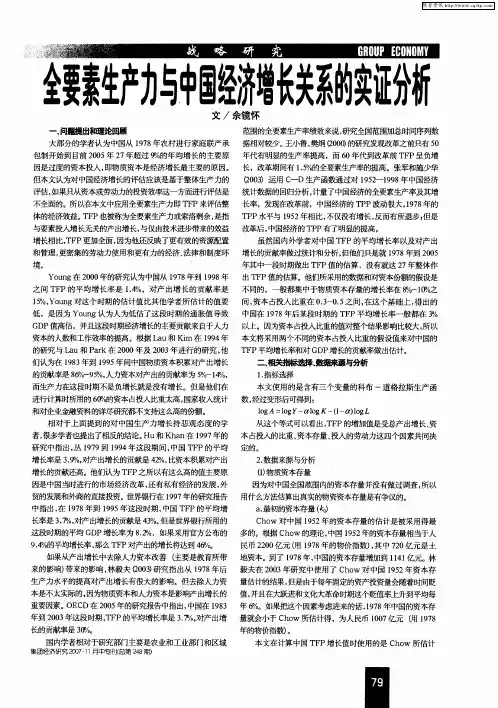
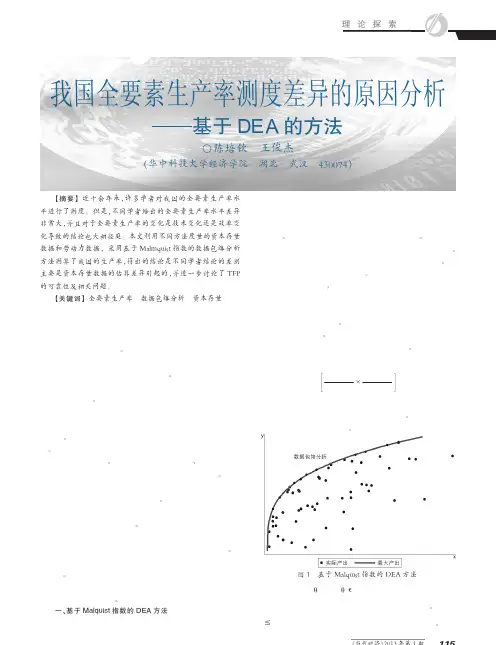
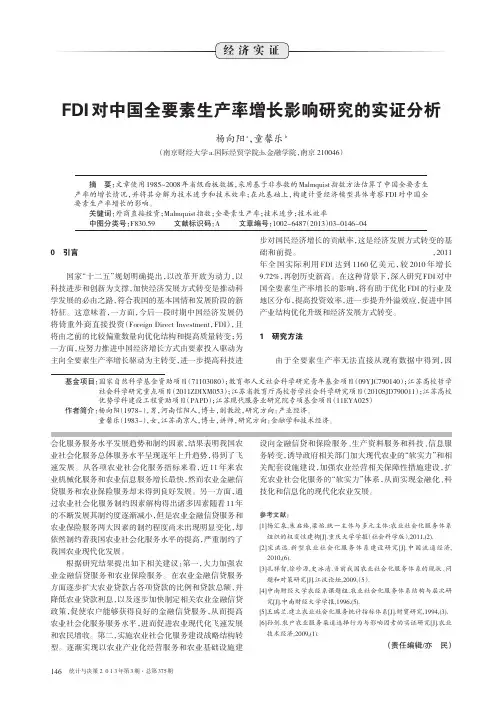
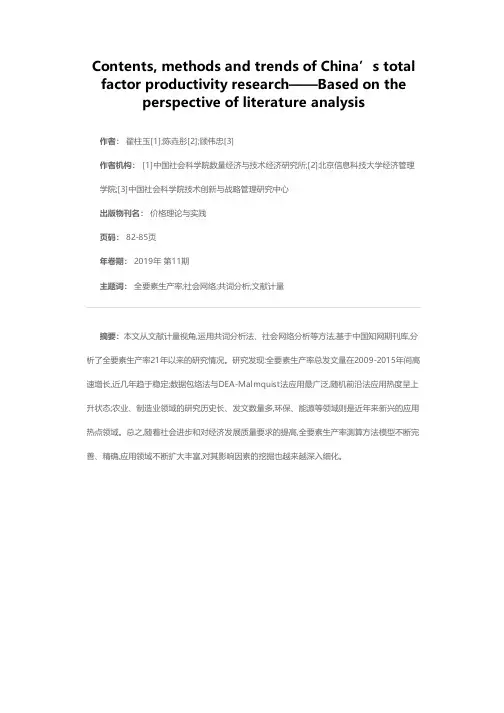
Contents, methods and trends of China’s total factor productivity research——Based on the perspective of literature analysis 作者: 翟柱玉[1];陈垚彤[2];顾伟忠[3]
作者机构: [1]中国社会科学院数量经济与技术经济研究所;[2]北京信息科技大学经济管理学院;[3]中国社会科学院技术创新与战略管理研究中心
出版物刊名: 价格理论与实践
页码: 82-85页
年卷期: 2019年 第11期
主题词: 全要素生产率;社会网络;共词分析;文献计量
摘要:本文从文献计量视角,运用共词分析法、社会网络分析等方法,基于中国知网期刊库,分析了全要素生产率21年以来的研究情况。
研究发现:全要素生产率总发文量在2009-2015年间高速增长,近几年趋于稳定;数据包络法与DEA-Malmquist法应用最广泛,随机前沿法应用热度呈上升状态;农业、制造业领域的研究历史长、发文数量多,环保、能源等领域则是近年来新兴的应用热点领域。
总之,随着社会进步和对经济发展质量要求的提高,全要素生产率测算方法模型不断完善、精确,应用领域不断扩大丰富,对其影响因素的挖掘也越来越深入细化。
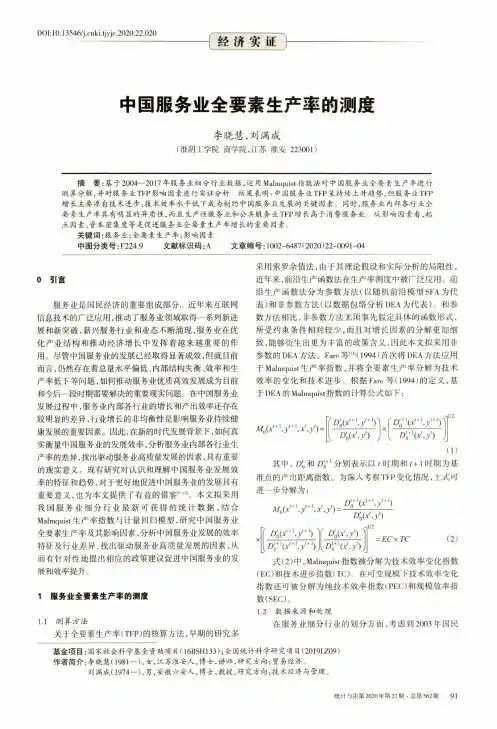
DOI:10.13546/ki.t j y j c.2020.22.020 (----------—-------------------经济实证中国服务业全要素生产率的测度李晓慧,刘满成(淮阴工学院商学院,江苏淮安223001)摘要:基于2004—2017年服务业细分行业数据,运用Malmquist指数法对中国服务业全要素生产率进行测算分解,并对服务业T F P影响因素进行实证分析。
结果表明:中国服务业T F P呈持续上升趋势,但服务业TFP 增长主要源自技术进步,技术效率水平低下成为制约中国服务业发展的关键因素。
同时,服务业内部各行业全 要素生产率具有明显的异质性,而且生产性服务业和公共服务业TFP增长高于消费服务业。
从影响因素看,起 点因素、资本密集度等是促进服务业全要素生产率增长的重要因素。
关键词:服务业;全要素生产率;影响因素中图分类号:F224.9 文献标识码:A文章编号:1002-6487(2020)22-0091-04〇引言服务业是国民经济的重要组成部分。
近年来互联网 信息技术的广泛应用,推动了服务业领域取得一系列新进 展和新突破,新兴服务行业和业态不断涌现,服务业在优 化产业结构和推动经济增长中发挥着越来越重要的作用。
尽管中国服务业的发展已经取得显著成效,但就目前 而言,仍然存在着总量水平偏低、内部结构失衡、效率和生 产率低下等问题,如何推动服务业优质高效发展成为目前 和今后一段时期需要解决的重要现实问题。
在中国服务业 发展过程中,服务业内部各行业的增长和产出效率还存在 较明显的差异,行业增长的非均衡性是影响服务业持续健 康发展的重要因素。
因此,在新的时代发展背景下,如何真 实衡量中国服务业的发展效率,分析服务业内部各行业生 产率的差异,找出驱动服务业高质量发展的因素,具有重要 的现实意义。
现有研究对认识和理解中国服务业发展效率的特征和趋势,对于更好地促进中国服务业的发展具有 重要意义,也为本文提供了有益的借鉴1M21。
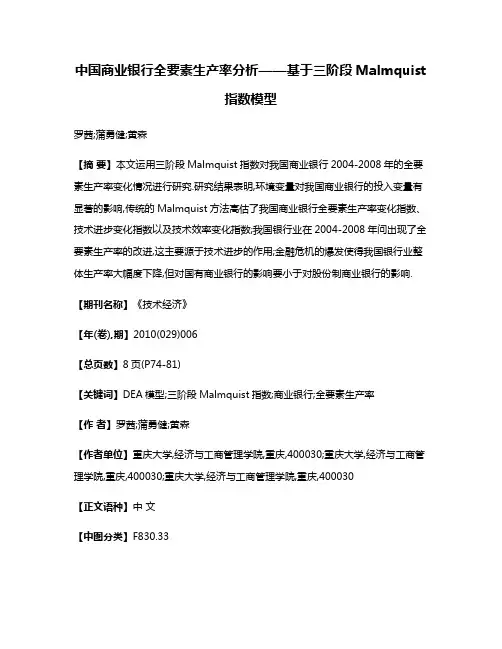
中国商业银行全要素生产率分析——基于三阶段Malmquist指数模型罗茜;蒲勇健;黄森【摘要】本文运用三阶段Malmquist指数对我国商业银行2004-2008年的全要素生产率变化情况进行研究.研究结果表明,环境变量对我国商业银行的投入变量有显著的影响,传统的Malmquist方法高估了我国商业银行全要素生产率变化指数、技术进步变化指数以及技术效率变化指数;我国银行业在2004-2008年问出现了全要素生产率的改进,这主要源于技术进步的作用;金融危机的爆发使得我国银行业整体生产率大幅度下降,但对国有商业银行的影响要小于对股份制商业银行的影响.【期刊名称】《技术经济》【年(卷),期】2010(029)006【总页数】8页(P74-81)【关键词】DEA模型;三阶段Malmquist指数;商业银行;全要素生产率【作者】罗茜;蒲勇健;黄森【作者单位】重庆大学,经济与工商管理学院,重庆,400030;重庆大学,经济与工商管理学院,重庆,400030;重庆大学,经济与工商管理学院,重庆,400030【正文语种】中文【中图分类】F830.331 研究背景2004年以来,大型商业银行先后上市,农业银行也积极准备,我国对外资银行的全面性开放,美国次贷危机的爆发等一系列事件对我国大部分上市银行产生了重大影响。
尽管我国银行业的资产规模不断扩大,如图1所示,但随着外资银行的全面准入和我国中小型城市商业银行、农村合作金融机构的蓬勃发展,我国银行业结构正在悄然发生变化。
我国国有商业银行的市场份额2004—2008年已经出现明显的下降趋势,虽然股份制商业银行市场份额有所增加,但是两者之和仍然出现了轻微下降,如图2所示。
这一系列事件使我们不得不对我国银行业的发展情况引起重视,特别是我国银行业的效率情况。
图1 我国银行业总资产规模图2 全国性银行市场份额(按资产)过去50年,国内外学者都致力于对银行效率的研究。
早期银行业效率研究主要包括规模经济效率和范围经济效率,近几年对银行效率的研究则集中于X效率和全要素生产率。
我国总量生产函数与全要素贡献率的测算作者:王云峰来源:《经济视野》2015年第04期【摘要】通过运用柯布—道格拉斯生产函数,对我国的国民生产总值进行测算。
并通过测算全要素贡献率,分析固定资本投资、劳动人数和技术进步对经济总量的贡献,找出近几年我国经济发展的不足,提出合理的意见和建议。
【关键词】C-D生产函数全要素贡献率 GDP技术进步在一定时期内,在技术水平不变的情况下,生产函数可以表示生产中所使用的各种生产要素的数量与所能生产的最大产量之间的关系。
柯布—道格拉斯生产函数引入了技术资源这一因素,是在生产函数的一般形式上作出的改进。
近几年来我国经济处于高速发展的态势,但其中也面临的诸多问题。
伴随2012年经济增速的频频走低,我国经济迎来了经济发展稳定期。
回顾历年中国经济的发展历程,对于认清当前经济发展所面临的问题具有十分重要的。
一、生产函数理论分析(一)柯布—道格拉斯生产函数柯布—道格拉斯生产函数最初是美国经济学家保罗·道格拉斯(Paul H. Douglas)和数学家柯布(C.W.Cobb)共同探讨投入和产出的关系时创造的生产函数。
柯布-道格拉斯生产函数的形式为:,其中,Y为总产出,A为技术进步,L为劳动投入,K为资本投入,和为参数,它们分别是资本和劳动的产出弹性。
C-D生产函数是非线性的生产函数,对于此类非线性函数,可以采用转化成线性模型的方式进行估计,对模型两端同时进行对数化处理,即lnY=LnA+lnL+InK,处理后的函数是明显的线性函数。
(二)关于K的测算方法永续盘存法主要由四个主要部分构成:1、确定基期资本存量。
2、选取当年投资指标I。
3、构造投资品价格指数。
4、确定经济折旧率。
(1)基期资本存量的确定。
基期资本存量的确定是学者们争论的焦点,由于不同学者采取的估算方法不同,得出的基期资本存量往往相去甚远。
基期资本存量的估算在已有的研究文献中一般选择1952年和1978年,当然,基年选择得越早越好,此时基期资本存量估计的误差对后续年份的影响就越小,限于数据条件和研究的需要,本文将基期定于1980年。
万方数据中国全要素生产率研究评述作者:段文斌, 尹向飞, Duan Wenbin, Yin Xiangfei作者单位:南开大学经济学院经济学系,300071刊名:南开经济研究英文刊名:NANKAI ECONOMIC STUDIES年,卷(期):2009(2)被引用次数:74次1.何锦义,刘晓静,刘树梅当前技术进步贡献率测算中的几个问题[期刊论文]-统计研究 2006(5)2.胡鞍钢;郑京海考虑环境因素的省级技术效率排名 2008(03)3.林毅夫,任若恩东亚经济增长模式相关争论的再探讨[期刊论文]-经济研究 2007(8)4.彭国华我国地区全要素生产率与人力资本构成[期刊论文]-中国工业经济 2007(2)5.孙新雷,钟培武改革开放后我国全要素生产率的变动与资本投入[期刊论文]-经济经纬 2006(5)6.涂正革,肖耿中国大中型工业的成本效率分析:1995~2002[期刊论文]-世界经济 2007(7)7.王兵,颜鹏飞技术效率、技术进步与东亚经济增长--基于APEC视角的实证分析[期刊论文]-经济研究 2007(5)8.易纲,樊纲,李岩关于中国经济增长与全要素生产率的理论思考[期刊论文]-经济研究 2003(8)9.于永达;吕冰洋中国生产率争论:方法的局限性和结论的不确定性 200810.张军资本形成、工业化与经济增长:中国的转轨特征[期刊论文]-经济研究 2002(6)11.郑京海;胡鞍钢中国改革时期省际生产率增长变化的实证分析 2005(02)12.郑玉歆全要素生产率的再认识--用TFP分析经济增长质量存在的若干局限[期刊论文]-数量经济技术经济研究2007(9)13.Aigner D J;Amemiya T;Poirier D J On the Estimation Of Production of Production Frontiers:Maximum Likelihood Estimation of The Parameters of a discontinuous Density Function 1976(02)14.Aigner D J;Lovell C A K;Schmidt P J Formulation and Estimation of Stochastic Frontier Production Function Models 1977(06)15.Chames A;Cooper W W;Rhodes E Measuring the efficiency ofdecision making units 1978(02)16.Fare Rolf;Shawna Grosskopf;Mary Norris;Zhongyang Zhang Productivity Growth.Technical Progress,and Efficiency Change in Industrialized Countries 1994(01)17.Felipe J Total Factor Productivity Growth in East Asia:A Critical Survey 1999(04)18.Jorgenson D W;g Grilliches Issues in Growth Accounting:A Reply to E.E Denison 1972(05)19.Kim Jong II;Lawrence Lau The Sources of Economic Growth of the East Asian Newly Industrialized Countries 1994(08)20.Kumbhakar S C;C A K Lovell Stochastic Frontier Analysis 200021.Solow R K Technical Change and the Aggregate Production Function 1957(39)22.参见Felipe(1999)和Chen(1997)对TFP研究的批评23.孙新雷改革开放后我国全要素生产率的变动和资本投入24.Formulation and Estimation of Stochastic Frontier Production Function Models25.傅晓霞;吴利学技术效率、资本深化和地区差异26.中国地区工业生产绩敛:结构差异、制度冲击及动态表现27.中国的工业生产力革命28.徐盈之中国信息制造业全素生产率变动、区域差异域影响因素研究29.FDI与中国全要索生产率的变动30.中国生产率争论1.赵奉军.高波.ZHAO Feng-jun.GAO Bo中国全要素生产率的顺周期特征与决定因素:1952-2007[期刊论文]-经济经纬2009(2)2.孟维华全要素生产率的历史回顾[期刊论文]-生产力研究2007(15)3.徐家杰.Xu Jiajie中国全要素生产率估计:1978-2006年[期刊论文]-亚太经济2007(6)4.赵家章.宗晓华全要素生产率、增长差异与区域经济收敛[期刊论文]-开发研究2009(1)5.刘秉镰.李清彬.Liu Binglian.Li Qingbin中国城市全要素生产率的动态实证分析:1990-2006——基于DEA模型的Malmquist指数方法[期刊论文]-南开经济研究2009(3)6.章祥荪.贵斌威中国全要素生产率分析:Malmquist指数法评述与应用[期刊论文]-数量经济技术经济研究2008,25(6)1.杨文爽,李春艳东北地区制造业全要素生产率增长率分解研究[期刊论文]-当代经济研究 2015(04)2.杨春,王明利基于Malmquist指数的农户肉牛养殖全要素生产率研究[期刊论文]-农业经济与管理 2013(03)3.李刚江苏省工业TFP增长与行业差异:2002-2008-基于DEA-Malmquist行业分析[期刊论文]-市场周刊·理论研究 2010(08)4.尹向飞中国工业行业全要素生产率测算--基于链式指数法[期刊论文]-湖南商学院学报 2013(02)5.许亚杰,丁伟基于扩展的索罗模型扬州市科技贡献率度量分析[期刊论文]-北方经贸 2011(06)6.陈培钦,王俊杰我国全要素生产率测度差异的原因分析--基于DEA的方法[期刊论文]-当代经济 2013(01)7.殷颂葵青海省全要素生产率估算及经济增长源泉分析:1952-2012[期刊论文]-山东行政学院学报 2014(07)8.陈诚基于序列DEA方法:中国全要素生产率的再测算[期刊论文]-武汉金融 2010(08)9.黄君江苏省制造业内外资企业全要素生产率研究--基于DEA-Malmquist的实证分析[期刊论文]-现代商贸工业2010(23)10.陈海丹中国农业绿色全要素生产率及其影响因素研究[学位论文]硕士 201111.真慕白技术进步对重庆市工业增长影响的实证分析[学位论文]硕士 201112.刘云芬,陈砺,王东红农业上市公司绩效与多元化研究[期刊论文]-开发研究 2014(02)13.李晓宁经济增长的技术进步效率研究:1978-2010[期刊论文]-科技进步与对策 2012(07)14.孙凤娥我国工业企业技术资产利润贡献份额的研究[学位论文]硕士 201115.孙永君资本效率对我国财政政策选择影响分析[期刊论文]-地方财政研究 2014(05)16.胡小渝我国沿海港口的全要素生产率研究--基于空间滞后模型的实证分析[期刊论文]-西南农业大学学报(社会科学版) 2014(01)17.李群峰粮食丰产科技工程对小麦全要素生产效率的影响--基于DEA-Malmquist方法[期刊论文]-湖北农业科学2013(06)18.芦丹,杨文华西北地区全要素生产率增长及其比较分析--基于三次产业的研究[期刊论文]-贵州商业高等专科学校学报 2012(04)19.周卫民非体现型技术进步外生于经济增长吗--管理要素的视角[期刊论文]-科学学与科学技术管理 2011(09)20.高国鹏全要素生产率与内蒙古地区增长差异:1987-2007[学位论文]硕士 201021.程建华,于戒严安徽省全要素生产率的测算与经济解释--基于时变产出份额改进的索洛残差法[期刊论文]-华东经济管理 2015(01)22.韩金雨甘肃经济增长因素分析研究--基于时间序列数据[期刊论文]-现代商贸工业 2012(22)23.洪兴建,罗刚飞中国全要素生产率:1995-2012年FP指数的测度与分解[期刊论文]-商业经济与管理 2014(10)24.彭继增,黄昕,邓伟对外直接投资逆向技术溢出效应和吸收能力的实证检验--基于1992~2011年数据[期刊论文] -武汉金融 2013(09)25.张辉中国产业结构与经济增长研究:1990-2012[期刊论文]-华东经济管理 2014(12)26.蒲勇健,种海港,张勇中国再生资源产业全要素生产率估算分析[期刊论文]-统计与信息论坛 2014(10)27.牛永泽,孙茂辉基于修正C-D函数模型的技术进步与经济增长测算--以甘肃省为例[期刊论文]-重庆交通大学学报(社会科学版) 2014(01)28.杨美基于DEA-Malmquist方法的江西省各设区市经济增长效率分析[期刊论文]-价格月刊 2011(10)29.斯琴陈巴尔虎旗和新巴尔虎左旗家庭生命周期与生产效率研究[学位论文]硕士 201130.殷颂葵青海省1990年至2012年经济发展质量评价[期刊论文]-攀登(汉文版) 2014(3)31.林志良,黄荣,魏骁基于DEA的中国经济增长资源利用效率探讨[期刊论文]-价格月刊 2013(06)32.牛永泽,孙茂辉欠发达地区技术进步与经济增长的实证研究--以甘肃省为例[期刊论文]-江西农业大学学报(社会科学版) 2013(03)33.江春,吴磊,滕芸中国全要素生产率的变化:2000-2008[期刊论文]-财经科学 2010(07)34.我国制造业技术效率的测算与变动研究[期刊论文]-北京邮电大学学报(社会科学版) 2014(03)35.马立军,何萍出口贸易、人力资本与中国全要素生产率--基于GMM估计的经验分析[期刊论文]-贵州财经大学学报 2013(06)36.王淑新,王学定,徐建卫中国西部地区旅游业全要素生产效率研究[期刊论文]-浙江工商大学学报 2012(03)37.李福柱,杨跃峰全要素生产率增长率的测算方法应用述评[期刊论文]-济南大学学报(社会科学版) 2013(02)38.陈媛中国区域建筑产业TFP变化趋势与影响机理的空间分析[学位论文]硕士 201339.赵可农地城市流转与经济增长质量研究[学位论文]博士 201140.潘诚技术进步对安徽省碳排放影响的研究[学位论文]硕士 201141.刘珂国土资源对产业经济发展的支撑作用研究——以土地资源为例[学位论文]博士 201042.刘春燕技术进步对中国就业影响的实证分析[学位论文]硕士 201043.雷淑伶中国粮食生产技术效率和技术进步分析[学位论文]硕士 201044.邓蕾中国集装箱港口企业生产率测度研究[学位论文]博士 201045.陈培钦中国高投资下的资本回报率研究[学位论文]博士 2013引用本文格式:段文斌.尹向飞.Duan Wenbin.Yin Xiangfei中国全要素生产率研究评述[期刊论文]-南开经济研究 2009(2)。
中国省际全要素生产率及其持续增长谭盟盟【摘要】基于DEA的Malmquist指数法,通过最新资本存量对我国30个省域经济(1978-2006)的TFP增速进行了测算,并对影响技术效率偏低的因素进行实证分析.①结果表明改革开放以来我国TFP保持了平均4.2%的增长,其中技术进步增长(3.5%)是推动TFP进步的主要因素,而技术效率增长偏低(0.6%);市场化和贷款比率对技术效率的提高有正向作用,行政管理成本严重负向影响技术效率,外资依存度和存款比率有较弱的负向影响.【期刊名称】《广西财经学院学报》【年(卷),期】2011(024)003【总页数】7页(P26-31,39)【关键词】全要素生产率(TFP);数据包络分析;Malmquist指数;技术效率【作者】谭盟盟【作者单位】重庆师范大学经济与管理学院,重庆401331【正文语种】中文【中图分类】F222.33全要素生产率(TFP)是指总产出与综合要素投入之比率,其在度量经济增长的质量和效率方面有无可替代的作用。
Tinbergen(1942)在柯布—道格拉斯函数的基础上提出了TFP的概念,Solow(1957)对其进行细化研究得出“索洛剩余”,激发起了人们对TFP研究的广泛兴趣。
Klenow and Rodriguez-Clare(1997)、Prescott(1999)、Hall and Jones(1999)、Easterly and Levine(2001)、Caselli(2006)等都通过研究证明了TFP在经济增长中的重要贡献。
近年来,许多文献通过不同方法测算出我国TFP增长率变化较低,并在很多年份出现负值,其原因在于我国是粗放型外延扩张的增长,但是TFP低增长甚至为负的结果与中国改革开放30年来实际GDP一直保持的较高水平增长的事实相违背。
本文在以往文献研究成果的基础上,重新估算了中国改革开放30年来的TFP增长率,发现已有的文献大多低估了TFP的增速。
第32卷第3期 2009年6月
石家庄经济学院学报
Journal of Shijiazhuang University of Economics Vo1.32 No.3
Jun.2008
闽台农业全要素生产率及其影响因素的估算分析 钟明春 (福建师范大学经济学院,福建福州350007) 摘要:文章主要运用全要素生产率模型对闽台两地1981年一2006年的全要素生产率的差异及 其影响因素进行分析 研究表明台湾历年的技术进步对经济增长的贡献基本都要大于福建,但是 福建技术进步的年均增长率要高于台湾:在技术进步的影响因素中,福建农业产业结构对 I1F’P增 长贡献最大,人力资本次之;而台湾的人力资本与科技研发对TFP增长贡献较大。
关键词:闽台;农业合作;生产要素率;估算分析 中图分类号:I ̄061.5 文献标识码:A 文章编号:1007—6875(2009)03—0029—05 自1980年代以来,闽台农业合作经历一个从 最初的隐蔽、零星、分散到现在的公开、规模、合 作深化的阶段,台湾先进的技术、雄厚的资本,福 建丰富的劳动力资源、廉价的土地,通过闽台双方 政策制度上的安排,使得资源要素的合理配置,整 合与优化得以可能?事实上,闽台农业经过二十几 年的合作,双方均取得了双赢的结果(林卿, 2004;陈志强,2006;李建华,2005等) 对于闽 台农业合作,两岸学术界的研究成果也可谓汗牛充 栋,但是从现有文献来看,尚未发现闽台农业全要 素生产率分析的相关研究。除了资本、劳动力等要 素投入外,其它因素对于闽台各自农业的产出贡献 有多大呢?研究这一问题对于充分发挥资本、土地 等要素的作用,转变经济增长方式无疑具有非常重 要的意义?基于此,本文试图采用全要素生产率 (TFP)模型对闽台两地1981年一2005年间的全要素 生产率及其影响因素的进行分析,以期为更好地实 现两岸资源要素的流动与优化配置提供决策参考: 一、理论分析与模型的建立 (一)全要素生产率及其因素分析 TFP问题由荷兰经济学家丁伯根(J.Tinbergen) 于1942年最早提出:随后相关的研究纷至踏来。 但是真正对全要素生产率展开比较系统的研究,当 属二十世纪五十年代的美国经济学家索洛:他 在 1957年的研究中发现,在经济增长的影响因素中, 除了资本与劳动的作用外,还存在着一个余值,这 个余值是仅凭资本和劳动是无法解释的;索洛将之 归结为科技进步的作用 这也就是有名的“索洛余 值”,即全要素生产率的增长率。美国经济学家肯 得里克则在对美国生产率的研究中发现,研发费 用、教育与培训费用对全要素生产率的变化具有非 常重要的影响,此外还认为资源配置状况、技术创 新的扩散程度、规模经济等也是其重要影响因 素 j,但是他没有进一步对此分析。开始对增长因 素进行分析的是美国经济学家丹尼森,二十世纪六 十年代初他在研究美国经济增长时,把影响国民收 入增长的因素分为两个:一是总投入,其中包括劳 动、资本和土地;二是单位投入的产出,其中他把 影响单位投入产出(即技术进步)的因子归结为资 源配置的改善、规模节约、知识进步和政策制度以 及其他一些不规则因素_3J3。 我国学者近年来对于全要素生产率的研究除了 集中研究代表技术进步的全要素生产率本身外,还 对全要素生产率的影响因素进行了分析。其中李明 智、王娅莉 4 结合高新技术产业的行业特点把技术 进步的影响因素归纳为企业内部R&D投入、公共 部门R&D投入与对外开放因素;王英伟、成邦 文_5 选择了国内研究与发展活动、产业结构与对外 开放作为全要素生产率的影响因素进行分析以探求 经济增长的源泉;金相郁【 则把造成全国各省或地 区全要素生产率差异的原因总结为生产规模、教育 水平、研发技术、人口规模、区域产业结构以及产 业基础设施六个方面;祖立义、傅新红、李冬梅l7 在研究我国1985年一2oo5年的种植业时,则把影 响种植业全要素生产率的因素分为改革开放、科研 成果、农技推广及结构调整等方面一总之,针对不 同的研究对象,所选取的影响因素亦不完全相同。